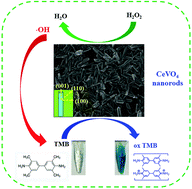Synthesis of EDTA-assisted CeVO4 nanorods as robust peroxidase mimics towards colorimetric detection of H2O2†
Abstract
In this paper, CeVO4 materials were developed as highly efficient biomimetic catalysts for the first time to detect H2O2. These CeVO4 materials were prepared by a facile hydrothermal method with the assistance of EDTA, exhibiting different morphologies, surface properties, and distinct peroxidase mimetic activities. Among them, CeVO4-2 nanorods (NRs) were proved to display the best intrinsic peroxidase-like property compared to other CeVO4 samples due to their more negative potential and larger BET specific surface area, which could efficiently catalyze the oxidation of 3,3′,5,5′-tetramethylbenzidine (TMB) in the presence of H2O2 to generate a blue oxide. Based on the excellent peroxidase mimetic catalytic activity of CeVO4-2 NRs, a simple, convenient and visual H2O2 detection system was successfully established. The detection limit of H2O2 could reach as low as 0.07 μM. Moreover, the CeVO4-2 NR-based assay system presented an excellent selectivity, practicability, long-term stability, and reusability. The peroxidase-like catalytic mechanism of CeVO4-2 NRs was proposed on the basis of active species trapping experiments. This work provides a novel, convenient, rapid, and ultrasensitive system for the colorimetric detection of H2O2, which has a bright prospect in H2O2 detection and biomedical analysis.


 Please wait while we load your content...
Please wait while we load your content...